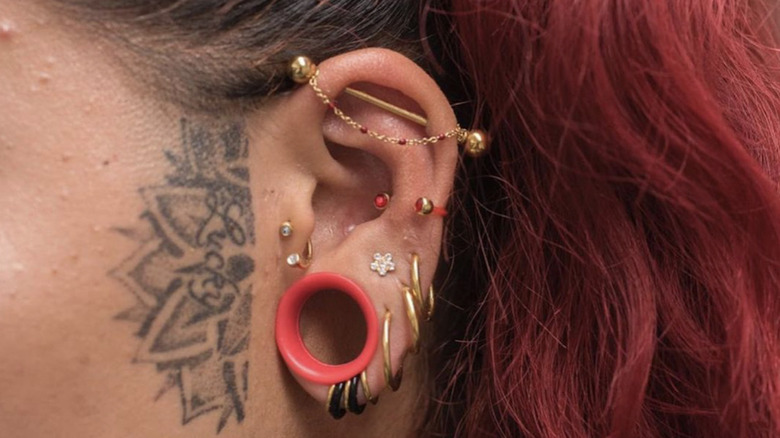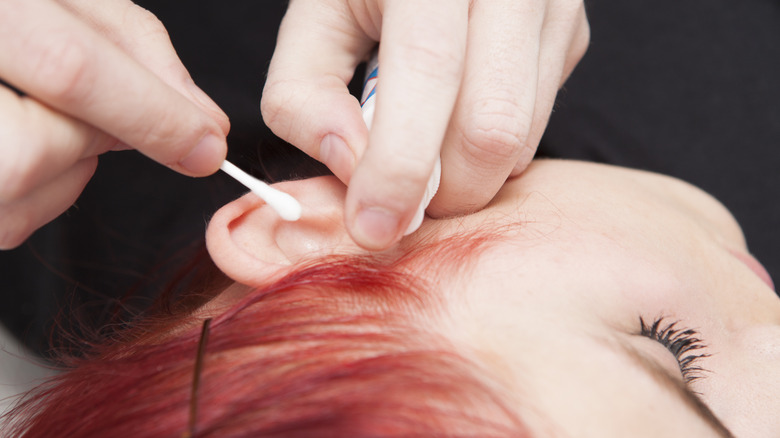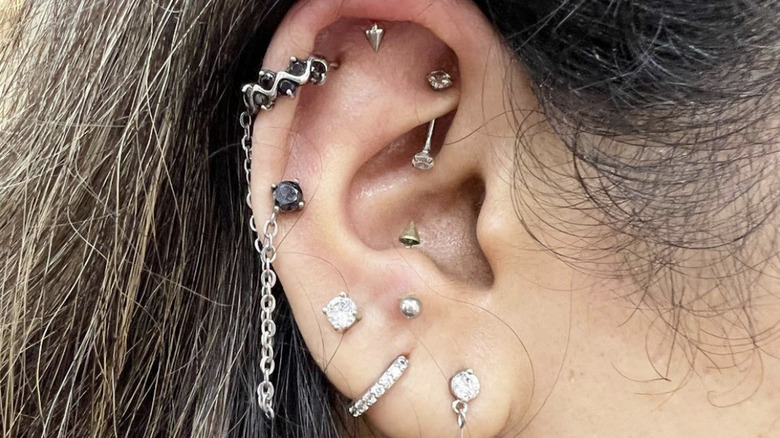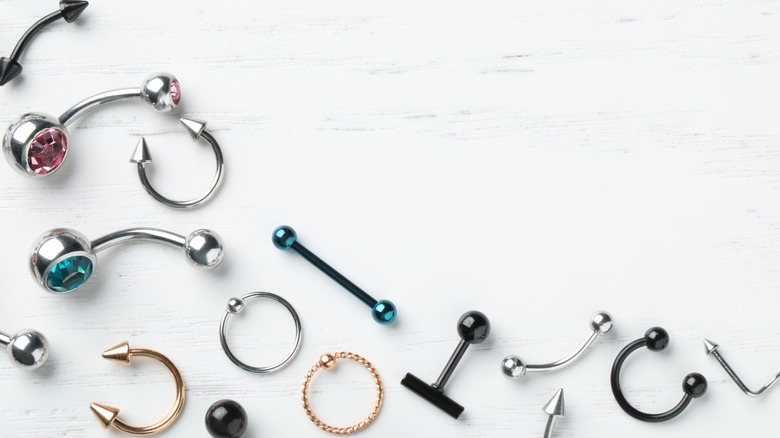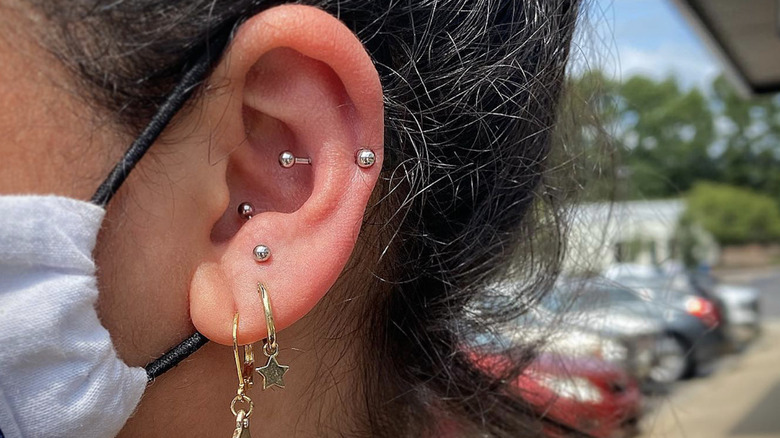What To Know Before You Get An Anti-Tragus Piercing
Piercings are a versatile form of body modification. Sometimes, they can be tame, like regular ear lobe piercings. Other times, they can be on the far end of many people's comfort zones, like nipple and genital piercings. But some offer just the right amount of flair, while still being practical. Cue the anti-tragus piercing. Located right next to the tragus, which is where it gets its name, the anti-tragus piercing is done on the small cartilage ridge on top of the earlobe. According to Fresh Trends Fine Body Jewelry, the anti-tragus is a small area and so can be difficult to pierce for some people. The ideal ear type for this piercing is one with a nub and fairly thin cartilage (via Infinite Body). Yet, the versatility that comes with an anti-tragus means you can pierce close to the area without piercing the actual cartilage and still get the look.
The anti-tragus is great for anyone who wants a little more edge in their style. There are a few things you need to know before and even after getting this piercing, so here's a quick anti-tragus 101 lesson.
Getting an anti-tragus piercing
As with all other piercings, you should only get your anti-tragus done with a reputable, experienced, and licensed piercer. After talking you through the procedure and aftercare, and choosing from the jewelry options available, your piercer will hand you some paperwork to sign. Once that's done, the piercing process begins with sterilizing the area. Piercee shares that your piercer will mark the area to be pierced with a surgical pen. You may have to look in the mirror to be sure you're satisfied with the proposed placement. Once you like the placement of the marker and give the go-ahead, your piercer will clamp the area with some forceps and quickly pierce it with the needle. With a receiving tube, your jewelry will be threaded through your new puncture, and you'll have your brand-new anti-tragus.
Being a cartilage piercing, the anti-tragus is pretty painful, coming at about a six to eight on a scale of 10 for most people. Pain levels do vary from person to person, as Spencer Gifts confirms that it depends on your pain tolerance and how thin or thick your cartilage is. But not to worry; it'll be over before you know it.
What about aftercare?
According to Maison Miru, minimal healing takes anywhere between two to four months, while a fully-healed anti-tragus can take up to a year. The anti-tragus is a cartilage piercing, and as such does not heal as fast as fleshy earlobe piercings due to lesser blood flow in the area, per Blue Banana. With proper aftercare, your piercing should be on its way to fully healing in the shortest amount of time. A quick reminder that your piercer, who again should be both experienced and licensed, would have explained the strict aftercare rules to you before or after the procedure. Aftercare helps keep the area free from infections, which equals smoother healing and a reduced chance of deforming your piercing.
As Right Piercing details, clean the area about two to three times daily with some sterile saline solution like the highly rated H2Ocean Piercing Aftercare Spray with Sea Salt. Do not move your jewelry around during or after cleaning as this can ruin the recently formed tissue and disrupt the healing process. Instead, dab around the area with your saline solution and clean non-woven gauze. The location of the anti-tragus means leaving things in your ear will be a bit difficult, so it's important to prepare for that difficulty. This includes earbuds, headphones, earphones, or even sharing pillows.
How much does it cost to get one?
Your anti-tragus could cost anywhere between $45 and $60, per TatRing. Body Piercing Mag explains that the price can be lower, at around $40. And for some, the price could be higher, coming at around $80 (via Industrie8 Body Piercing). Prices vary depending on the location of the salon and how experienced the piercer is. Most times, jewelry is a separate cost from the piercing fee, and with the anti-tragus, you have plenty of options — a perk few piercings give. On Pierced's list of options are press-fits, curved barbells, circular horseshoe barbells, studs, and spiral barbells. To prevent your piercing from closing up, Maison Miru advises you to go for 16-gauge jewelry, which is thick enough to keep the new puncture open.
Piercings take time to heal and removing the jewelry before healing is done can cause infections or cause the piercing to close up. This is why The Black Hat Tattoo advises not to rush into a jewelry change. Always go for high-quality jewelry made of materials like titanium, surgical steel, and platinum.
What to look out for during healing
Like all piercings, your anti-tragus is at risk of infections too. As Pierced explains, swelling is normal and may even persist for weeks as the area is inflamed. The inflammation can also persist when you sleep on your side with the piercing or move the jewelry around with your hands or music-playing devices. In this case, taking some over-the-counter painkillers and sleeping on your back will also help. An extra tip from Healthline is to place a warm compress on the anti-tragus to help with wound healing. It's crucial that you monitor the color and consistency of fluid that leaves the area. Usually, transparent liquid that dries down into a crust is not a bad sign for piercings. However, colored or smelly pus, whether yellow or even green, is cause for concern and is indicative of infections in your piercing.
All in all, the anti-tragus is a great option for any all-rounder: It's fun, it's versatile, and it's edgy. Remember to get the procedure done only with a licensed, experienced, and reputable piercer, and to take your aftercare seriously. Life's just too short for regular piercings.
